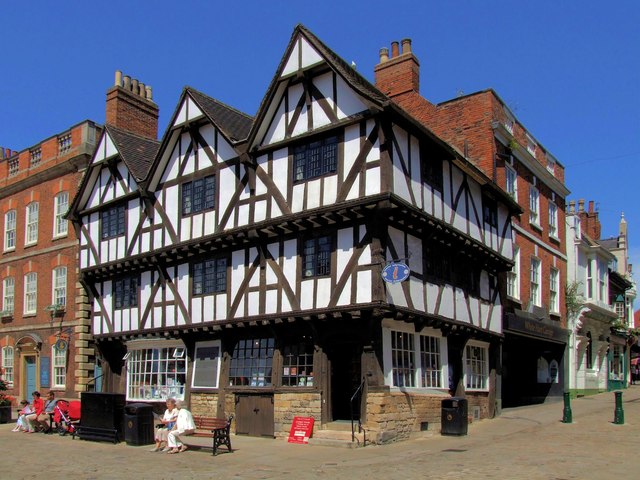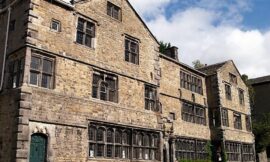Introduction
Pemberton House, located in the heart of Lincoln, England, is a remarkable example of 17th-century architecture that stands as a testament to the city’s rich history. This Grade II listed building, with its distinctive timber-framed construction and historical significance, offers a glimpse into the past while continuing to serve as a beloved landmark in Lincoln’s vibrant cultural landscape. This essay delves into the history, architectural features, and cultural significance of Pemberton House, exploring its journey from a private residence to a cherished piece of Lincoln’s heritage.
Historical Background
Pemberton House was constructed in the late 16th or early 17th century during a time of significant change in England. The period was marked by the Elizabethan and Jacobean eras, a time of exploration, cultural development, and architectural evolution. Timber-framed houses like Pemberton House were common during this time, reflecting the architectural trends of the period.
The house was originally built as a private residence for a wealthy merchant family in Lincoln. At that time, Lincoln was a thriving market town and an important center of commerce. The city’s prosperity was reflected in the construction of grand houses for its merchants and other affluent residents. Pemberton House, with its timber framing and elegant design, exemplifies the kind of homes that were built for the city’s elite.
Throughout its history, Pemberton House has undergone various changes in ownership and use. While initially a private residence, it has also served different purposes over the centuries, including as commercial premises and offices. Despite these changes, the house has retained much of its original character and continues to be a prominent feature of Lincoln’s historic streetscape.
Architectural Features
Pemberton House is an excellent example of half-timbered architecture, a style that was prevalent in England during the Tudor and early Stuart periods. This style is characterized by exposed wooden frames, often infilled with plaster or brick, which create a striking and intricate pattern on the building’s façade.
1. Timber-Framed Construction
The most distinctive feature of Pemberton House is its timber-framed construction. The exposed wooden beams form a visible structural framework that is both decorative and functional. This type of construction was not only practical, given the abundance of wood in England at the time, but also allowed for elaborate designs and patterns to be incorporated into the building’s exterior.
The beams of Pemberton House are arranged in a grid-like pattern, with horizontal, vertical, and diagonal elements that create a sense of symmetry and order. The spaces between the timber frames are filled with white plaster, which contrasts sharply with the dark wood, creating a striking visual effect that is characteristic of this architectural style.
2. Jettied Upper Floor
One of the notable architectural features of Pemberton House is its jettied upper floor. In medieval and early modern English architecture, it was common for upper stories to project beyond the lower walls of a building. This feature, known as a jetty, was both an aesthetic and practical choice. Aesthetic because it added visual interest to the building’s façade, and practical because it provided additional space on the upper floors without encroaching on the street below.
The jettied upper floor of Pemberton House adds to its distinctive silhouette and is a key feature of its historical charm. The overhang created by the jetty casts shadows that highlight the building’s structure and craftsmanship, emphasizing the skill and artistry of the builders who constructed it.
3. Decorative Carvings and Detailing
Pemberton House is also adorned with decorative carvings and detailing that reflect the craftsmanship of the period. The wooden beams are not only structural elements but are also used as a canvas for decorative motifs. These carvings often include floral patterns, geometric designs, and other embellishments that add to the building’s visual appeal.
The intricate detailing of the timber frames and carvings exemplifies the high level of craftsmanship that went into the construction of Pemberton House. These details provide insight into the aesthetic values of the time and showcase the skill of the artisans who built the house.
Cultural and Historical Significance
Pemberton House is more than just an architectural gem; it is a significant part of Lincoln’s cultural and historical heritage. Its preservation and continued use reflect the city’s commitment to honoring its past while adapting to contemporary needs.
1. A Window into the Past
As a well-preserved example of 17th-century architecture, Pemberton House serves as a tangible link to Lincoln’s history. The house offers a window into the lives of the city’s wealthy residents during a time of economic prosperity and social change. It provides insight into the domestic architecture of the period and allows visitors to imagine what life was like in Lincoln over 400 years ago.
The house also reflects broader historical trends, such as the growth of the merchant class and the increasing importance of trade and commerce in early modern England. By studying Pemberton House, historians can gain a better understanding of the social and economic forces that shaped Lincoln and other similar towns during this period.
2. Heritage Preservation
Pemberton House is a valuable part of Lincoln’s architectural heritage, and its preservation has been a priority for local authorities and heritage organizations. As a Grade II listed building, it is protected by law, which ensures that its historical character is preserved for future generations.
The listing recognizes the building’s architectural and historical significance and provides guidelines for its maintenance and restoration. Efforts to preserve Pemberton House include regular inspections, repairs to the timber frames and plasterwork, and careful management of any alterations to ensure that they are in keeping with the building’s historical character.
3. A Living Landmark
Today, Pemberton House continues to be a living landmark in Lincoln. It is not just a relic of the past but an active part of the city’s present. The building has been adapted for modern use while retaining its historical features, demonstrating how historic buildings can be successfully integrated into contemporary urban life.
Pemberton House currently serves various functions, including as offices, shops, or other commercial premises. Its central location in Lincoln makes it a prominent feature of the city’s streetscape, and its distinctive appearance attracts the attention of both locals and visitors.
4. Tourism and Education
Pemberton House also plays a role in Lincoln’s tourism industry. Its historical significance and architectural beauty make it a point of interest for tourists exploring the city’s rich heritage. Guided tours of Lincoln often include a stop at Pemberton House, where visitors can learn about the history of the building and the broader context of Lincoln’s development.
Educational initiatives also use Pemberton House as a resource for teaching about architectural history, local history, and heritage preservation. Schools, universities, and heritage groups often use the building as a case study for exploring these topics, highlighting its value as an educational tool.
Conclusion
Pemberton House stands as a remarkable example of 17th-century timber-framed architecture and a testament to Lincoln’s rich historical legacy. Its distinctive appearance, with exposed timber beams, jettied upper floors, and decorative carvings, captures the essence of the period in which it was built and offers a glimpse into the lives of Lincoln’s past residents.
Beyond its architectural significance, Pemberton House is a cherished part of Lincoln’s cultural heritage. Its preservation as a Grade II listed building ensures that it remains a visible and tangible link to the city’s history, serving as both a tourist attraction and an educational resource.
As a living landmark, Pemberton House continues to play a role in the life of Lincoln, demonstrating how historic buildings can be adapted for modern use while preserving their historical character. Through its preservation and continued relevance, Pemberton House embodies the enduring connection between Lincoln’s past and present, making it a vital part of the city’s identity and heritage.



